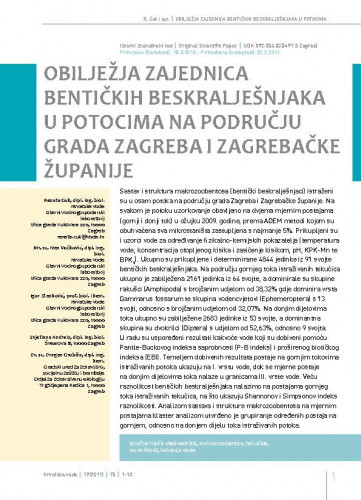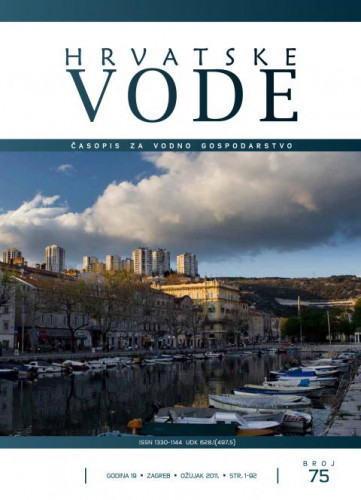Sastav i struktura makrozoobentosa (bentički beskralješnjaci) istraženi su u osam potoka na području Grada Zagreba i Zagrebačke županije. Na svakom je potoku uzorkovanje obavljeno na dvjema mjernim postajama (gornji i donji tok) u ožujku 2009. godine, prema AQEM metodi kojom su obuhvaćena sva mikrostaništa zastupljena s najmanje 5%. Prikupljeni su i uzorci vode za određivanje fizikalno-kemijskih pokazatelja (temperatura vode, koncentracija otopljenog kisika i zasićenje kisikom, pH, KPK-Mn te BPK5). Ukupno su prikupljene i determinirane 4844 jedinke iz 91 svojte bentičkih beskralješnjaka. Na području gornjeg toka istraživanih tekućica ukupno je zabilježena 2161 jedinka iz 64 svojte, a dominirale su skupine rakušci (Amphipoda) s brojčanim udjelom od 38,32% gdje dominira vrsta Gammarus fossarum te skupina vodencvjetovi (Ephemeroptera) s 13 svojti, odnosno s brojčanim udjelom od 32,07%. Na donjim dijelovima toka ukupno su zabilježene 2683 jedinke iz 53 svojte, a dominantna skupina su dvokrilci (Diptera) s udjelom od 52,63%, odnosno 9 svojta. U radu su uspoređeni rezultati kakvoće vode koji su dobiveni pomoću Pantle-Buckovog indeksa saprobnosti (P-B indeks) i proširenog biotičkog indeksa (EBI). Temeljem dobivenih rezultata postaje na gornjim tokovima istraživanih potoka ukazuju na I. vrstu vode, dok se mjerne postaje na donjim dijelovima toka nalaze u granicama III. vrste vode. Veću raznolikost bentičkih beskralješnjaka nalazimo na postajama gornjeg toka istraživanih tekućica, na što ukazuju Shannonov i Simpsonov indeks raznolikosti. Analizom sastava i strukture makrozoobentosa na mjernim postajama klaster analizom utvrđeno je grupiranje određenih postaja na gornjem, odnosno na donjem dijelu toka istraživanih potoka..; Structure and composition of macrozoobenthos (benthic invertebrates) were studied in eight streams in the area of Zagreb and Zagreb County. On each stream, sampling was conducted at two sampling stations (upper and lower part) in March 2009 by applying the AQEM method, which includes all microhabitats represented with at least 5%. Samples of water were taken for physico-chemical analysis (water temperature, dissolved oxygen and oxygen saturation, pH, COD-Mn, BOD5). A total of 4844 individuals from 91 taxa of benthic invertebrates were collected and determined. In the upper parts of streams, a total of 2161 individuals from 64 taxa were identified, with the domination of amphipods (Amphipoda) with 38.32% (dominant species Gammarus fossarum) and mayflies (Ephemeroptera) with 32.07% (13 taxa). In the lower parts, a total of 2683 individuals from 53 taxa were identified, with the domination of true flies (Diptera) with 52.63% (9 taxa). The results of water quality according to the Pantle-Buck (P-B index) and extended biotic index (EBI) were compared. The obtained results for the sampling station in the upper parts indicate the I. class of water quality, while the sampling stations in the lower parts indicate the III. class of water quality. Biodiversity and community of macroinvertebrates were compared in the upper and lower parts by using the Shannon and Simpson diversity indices, which both show greater biodiversity in the upper parts of streams. Cluster analysis of composition and structure of macrozoobenthos at the sampling stations identified a grouping of some stations in the upper part and also of some in the lower part of the streams.
Sažetak
Dio sveska

